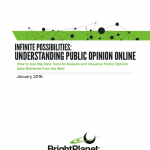Why You Should Be Using Data-as-a-Service in 2016
2016 is underway and the concept that still dominates the tech world is Big Data. The Economist Intelligence Unit surveyed executives and found that an estimated 60% of executives report generating revenue from their Big Data initiatives.
It’s clear that the concept of Big Data is here to stay, but we anticipate a few changes in 2016 to Big Data that will be for the better. In this post, we explore some predictions to help you better understand where Big Data is headed.
Data-as-a-Service is the next big thing
Over the past few years we’ve seen Big Data come to life from being mostly a buzzword in 2012 to a more pragmatic concept with real return on investment in 2014 and 2015. Fortune 500 companies across an array of industries including retail, pharmaceutical, and financial services invested millions of dollars adopting the latest Big Data technologies and hiring Big Data experts to get the most out of their data.
Up until the last 18 months the use of Big Data seemed out of reach for small to medium businesses that were not currently in the data business due to the cost and complexity of data. This demand for data specialists and technologies from businesses and groups perhaps not ready to hire their own staff internally created a market ready for a service offering, more specifically Data-as-a-Service (DaaS).
BrightPlanet’s first prediction for 2016 is that Data-as-a-Service is going to continue to grow.
In early 2015 we saw smaller technology providers (like Cazena, Reltio and us) begin offering Data-as-a-Service and late last year larger organizations such as Oracle and HP joined the mix of DaaS providers. Watch for a lot more Data-as-a-Service offerings to help compliment the growing amount of vendors and help companies capitalize on Big Data.
This move towards Data-as-a-Service by companies will benefit business groups heavily as it takes away the need for IT departments to be involved in every Big Data project. This will bring large amounts of quality data to business groups across an entire organization and encourage adoption of data projects to the masses regardless of technical capabilities.
Storytelling from data will need to evolve
Because of the adoption of data projects across industries and across user groups in varying technical capabilities, better analysis and storytelling from data will be happening.
The major problem that exists with analytic and data visualization technology is that oftentimes custom development is required to use and implement tools and services which makes it unattainable for less technical users.
BrightPlanet’s second prediction of 2016 is that data will be made available to the masses through better, easier to use tools and technologies.
The advantage for business analysts is that it’s only going to get easier for them to find the stories with the new services and technologies that are available. Business and data analysts in their individual business groups will be leading the charge in identifying these new technologies and products to help better analyze data without the need for customized development, or any development for that matter. They can then use these tools to find the right stories and visualize the data to distribute it out to the other business groups.
Tools like Tableau and Tibco Spotfire have easy to use interfaces to help organize and visualize data in custom dashboards in drag and drop environments without the need for involvement from a development team. Be on the lookout for analytic tools like these for user groups other than developers this coming year.
DATAFICATION
You may be wondering where all the data for Data-as-a-Service and storytelling is coming from. That’s where datafication comes in. Datafication is the idea that everything is turning into some type of data that can be tracked and stored into some type of database, and we couldn’t agree more. This concept of data leads to our third and final prediction.
BrightPlanet’s third prediction for 2016 is that more emphasis is going to be made on data that has gone external.
Datafication has created data sets about people that hadn’t previously existed. Friendships between people are now available online through Facebook and Twitter interactions. People’s thoughts on products and services are available on sites like Yelp and Amazon reviews. Media perception and public opinion of candidates are available in news articles and social media postings online. Products are sold fraudulently on e-commerce sites.
All these sources will contribute to datafication. They are all external to a company and available online. We anticipate that more and more companies will be tapping into external, publicly available data sets for a multitude of reasons in 2016.
How to get started in 2016
At this point, there is no doubt that data is important. 2015 saw several service providers release data service offerings and organizations continue to figure out the best ways to harness and analyze their data that inevitably exists.
Want to figure out how Data-as-a-Service might be able to increase revenue, efficiency, and/or strategic insight for your organization? Check out our Data-as-a-Service page for more information and request a demo with one of our data acquisition engineers.
//




